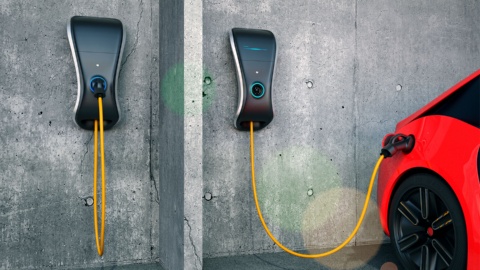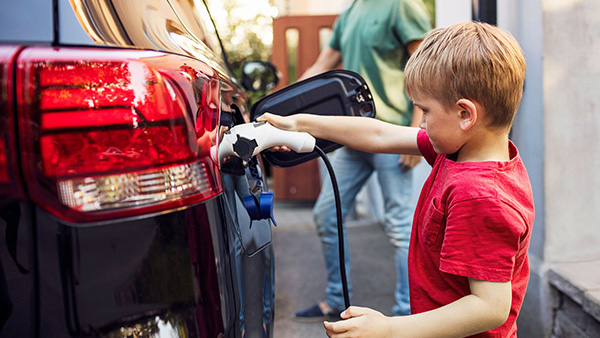
Our mobility is constantly changing. Where this journey takes us will be determined by changes in our lifestyle and increasing awareness for a more sustainable future. It’s clear that the future of our mobility lies in electrification. E-cars produce no emissions. With the help of sustainably generated energy, they are also CO2 neutral in a broader sense. However, at present, few people are prepared to drive an e-car.
The widespread belief is that the cars are too expensive, take too long to charge, and don’t drive far enough. But these scenarios could soon be a thing of the past. Whether it’s a comprehensive charging infrastructure, development of fast charging stations, or the efficiency of the batteries, a number of innovations are on the horizon. It is, among others, the chip industry that is enabling the mobility of the future with new materials and technologies.
Why do so few people drive e-cars?
Ubiquitous: Charging batteries in everyday life
We all do it – and we do it constantly: Charge batteries. In many cases even without knowing what’s actually happening in our gadgets. The modern smartphone now needs charging every day. We place our electric toothbrush on the charging station overnight. As a matter of course, we also charge portable speakers, smart watches and e-bikes. These charging processes fit seamlessly into our everyday lives and offer maximum convenience with minimum effort: plug in, lean back, done. In principle, the charging process for an e-car is just as simple. Nevertheless, many people dread the thought. Why is that?

Charging e-cars – can it be done faster?
Charging a smartphone, toothbrush or e-cars? From a technical aspect, the process is the same. In all cases, electrical energy is stored in chemical form. However, if you look more closely, you see that there are major differences. Mobile phones can do two things at once: charge and work. The e-car doesn’t offer that luxury. It’s not a technical factor but it’s still significant: We find it normal to charge a toothbrush overnight so that it works the next morning for a few minutes. But when it comes to e-cars, most people regard this as unreasonable – although in most cases, the vehicle is not used for 23 hours a day.
Motorists have become used to driving long distances with their vehicle whenever they want or have to. But with e-cars, this is exactly what appears to be impossible. Yet times have changed! Thanks to technical innovations, we can also experience this freedom with e-cars. Batteries are being developed that enable performance that was previously considered unconceivable. In addition, fast charging stations provide the energy required for huge distances within just a few minutes.
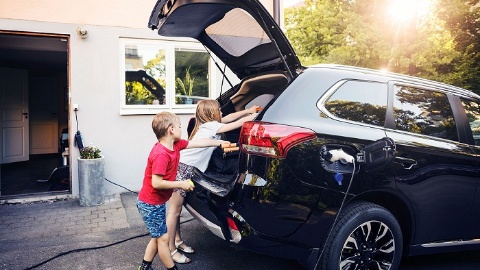
Further development of batteries and charging time
Already a thing of the past: short distances and long charging times
The days when a passenger car equipped with lead batteries could travel no further than 100 kilometers are a distant memory. Just like charging for hours on end. In 1995, Volkswagen built the Golf 3 City Stromer, a car with lead gel batteries that was able to drive up to 55 kilometers. The battery capacity was later increased, which extended the range to 65 kilometers. This may not sound much – but we must remember that a spacious vehicle had to be moved. The charger in the vehicle was designed only for a normal household electric socket which limited the power output. Charging the empty battery cells easily took six to eight hours. A journey of 100 kilometers was possible only with an overnight stay.
These days, e-cars have batteries with much higher capacities. But that’s by no means the end of the story. New discoveries are being made every day.
But the key question remains: How can the battery of an e-car be made more efficient and powerful?
What can batteries do?
Essentially, two parameters of a battery determine how much power a battery set can provide to an engine – and the power with which the battery set can be charged. On the one hand, this is the capacity of the cells. This expresses in ampere-hours (Ah) the maximum charge that can be stored in chemical form. On the other, there is the power density of a battery. This defines how large and heavy a battery must be for a defined power level. The power density is determined by the materials used. The first lead battery was introduced in the middle of the 19th century; today’s lithium ion batteries can hold up to seven times the charge of a lead battery of the same size.
Battery management in e-cars
The battery of an e-car must be used as efficiently as possible. This is ensured by a smart battery management system (BMS), which controls the charging and discharging of the battery and ensures optimum use of the battery cells. The system checks the individual cells and actively balances their charging. This effectively increases the life and range of the battery. The system solution from Infineon increases useful battery capacity by more than ten percent. Microcontrollers and sensors monitor the functionality and charging level.
Charging e-cars – now and in the future

The ratio between battery size and charging current is important when charging a battery. For example, since 2016, the BMW i3 has had a battery capacity of 95 Ah. If a 100 Ah battery could be charged continuously with a current of 100 ampere (A), it would theoretically take an hour to fully charge.
To charge a battery with 100 Ah at the current normal voltage of 400 volt (V) in one hour would require an approximate charging power of 40 kilowatts (kW). With up to 50 kW, current DV charging devices already often supply more.
Is that already “fast charging?” Not really. Only roughly the amount of current needed for a range of 200 kilometers can be transferred in one hour.
This should allow a battery to be charged with power of up to 350 kW. If it could handle this, a 60kWh (Average voltage of an electric car battery 400V-800V x ampere hours 100 = 60kWh) battery would be full in just a few minutes. At present, this high charging power is not supported for any serial vehicle in the world. However, there are several models on the market that can make use of this new charging technology – even though with lower kW figures.
How long does it take to charge an e-car?
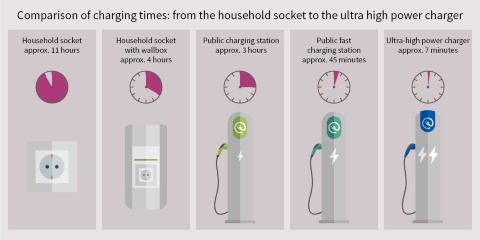
A glimpse behind the scenes
Organizations such as the Charging Interface Initiative (CharIN) have been established to ensure an appropriate charging infrastructure worldwide. They develop, establish, and promote global standards for the charging infrastructure for e-cars. Infineon supports CharIN with extensive experience in the areas of electric mobility, vehicle and data security. As a member, Infineon helps make chargers for electric mobility safe, efficient, and fast and contributes to the establishment of an efficient charging infrastructure.

Challenges associated with fast charging stations
Development of powerful charging stations
Fast charging stations should be available worldwide. That alone is already a major challenge. However, before fast charging stations can be integrated comprehensively into the infrastructure, several technical obstacles have to be overcome. This applies especially to the high power output. The Combined Charging Standard (CCS) allows output voltages above 500 V. As a rule, these are voltages that only trained experts are allowed to handle. It is therefore necessary to have uniform plug connections that withstand the high stresses and safety protocols that allow handling by non-professionals.
Another difficulty is that the energy supplied from the grid must be compatible with automotive batteries. Why is this a challenge? Batteries are DC voltage sources. The voltage from the electricity grid is an AC voltage and is therefore not suitable for charging the battery. Power electronic energy converters are needed to rectify the voltage. This makes the supplied voltage compatible with automotive batteries. AC voltage is converted to DC voltage.
Power losses and heat: How these are handled
The charging station must convert the AC voltage from the electricity grid to a DC voltage that is suitable for the battery in the automobile. When this happens, the components that are used cause what is known as power dissipation. In other words, energy is emitted in the form of heat. In extreme cases, this heat can destroy the device. With the planned high power levels, considerable losses and high temperatures occur even when electricity is being fed to the e-car. Without intensive cooling, there is a problem: Either the cable cross sections are extremely large and awkward or the insulation melts.
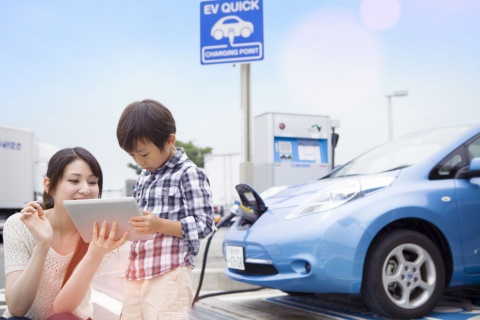
Charging e-cars quickly, efficiently, and safely
Optimizing efficiency
Liquid-cooled electric cables are required to prevent overheating. This allows the use of a relatively thin charging cable that is easy to handle from the charging station to the car. At the same time, the losses when charging an e-car must be reduced as much as possible. This requires efficient power electronics, which converts the AC voltage from the grid into DC voltage for the car battery. Losses must be kept as low as possible. Even a supposedly high efficiency level of 97 percent still causes high losses. To clarify: With a charge of 300 kW, 97 percent efficiency means power dissipation of 9 kW. This is like putting eight hairdryers running at full power into a freezer and expecting the inside of the freezer to not heat up.
Products from Infineon increase the efficiency
In the small installation space of the charging station, high power inevitably produces extremely high temperatures. Heat puts operation of the surrounding electronics at risk. It is easier to cool the charging station if the efficiency of the energy conversion is 99 percent or higher. That’s because no heat occurs where losses are as small as possible. Modern power chips from Infineon are at the heart of this development. They have been installed in a similar form in other applications for many decades, such as electricity generation from wind turbines or photovoltaics, drive systems in electric locomotives, and charging mobile phones. These chips have now reached a level of efficiency that was regarded as complete fiction just a few years ago.
It’s all down to the material

Promising developments have also been made with regard to the materials. Or to be more precise, the materials silicon carbide (SiC) and gallium nitride (GaN). These materials enable production of components that are smaller and also more efficient. As a result, they are extremely useful in efficiency-driven applications, such as charging stations for e-cars. Infineon is already developing highly efficient SiC modules. These have quickly established themselves in the solar industry where there is a similarly high demand for higher levels of efficiency. The experiences acquired there were used to develop highly efficient circuits which are now used in electric mobility. Innovative technology from Infineon can be found in new charging stations for e-cars, which should reduce charging time from three hours to a few minutes.
When will the first fast charging stations be reality?
The first charging stations which are able to provide sufficient charge to the cells of modern e-cars for 100 km in less than five minutes, despite their manageable size, are already installed in Germany. Just in time for the first vehicles that fulfill the high standards necessary for fast charging. This will make driving and charging e-cars much more attractive. A fact that has also been recognized by the German government which is now supporting the expansion of fast-charging stations on the Autobahn (highway) and in remote regions with a total of 2 billion euros. Because of that, long waiting times during charging and short ranges will be a thing of the past.
Another contributor to the growing fast charging infrastructure in Europe is the Ionity. The company is a joint venture by the German carmakers Volkswagen (VW, Audi and Porsche), Mercedes, BMW (with Mini) as well as Ford and Hyundai. The aim of the enterprise is to equip long-distance routes in Europe with HPC (High Power Charger). The plan is to build 400 charging parks with up to 350kw charging stations using the European CSS standard.
There, current top models such as the BMW ix3 can be charged up to 80% in just over half an hour with a maximum charging power of up to 150 kW.
Last update: July 2021
